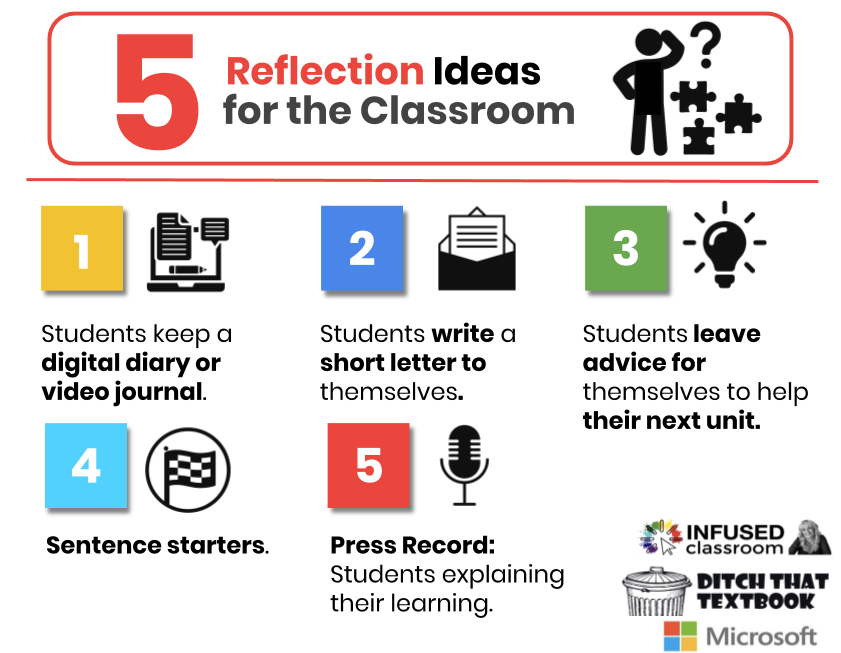The Infused Classroom Blog
Reflection Ideas for The Classroom
Share Post
Reflection Ideas for The Classroom: The Why
As educators, our job is to help students make meaning of concepts and ideas. We want our students to construct knowledge, to be creators of their learning, not just information consumers that parrot information back to us. In the end, we want the experiences in our classroom to inspire curiosity and a love of learning that will last a lifetime.
A reflective practice is an important shift that should be a top goal in a student centered classroom It is not an easy process, so it often gets overlooked as teachers rush to cover content in an already overcrowded curriculum. The truth is, this step is probably left out for two reasons. First, it is not easy to get students who have never been asked to reflect on their learning, to do it well. Second, most teachers have not been taught to academically reflect and thus don’t know where to begin teaching the process with to their own students.
How to Get Started with Reflection
We have all been there, unsure of how to start a new teaching strategy correctly, but this is what makes if fun! It's a new skill and it will take some learning, but think of it as an educational adventure because when you see how much this helps your students understand the content, who they are as learners, and how they can apply that knowledge to future learning - you will be hooked. It is an adventure that is like owning a puppy - you can't believe how much work it is, but when it matures it becomes your best friend.
We have to teach students how to reflect. They need to understand that there is a specific time in all learning, where we stop and look back at the journey and how we arrived at true academic knowledge. This happens when students comment on , connect with and reassess the process. This is assessment AS learning, and it is often as important to student learning and growth as the content itself.
What Can Reflection in the Classroom Look Like?
A reflective classroom includes both oral and text-based reflections. It is based in questions and routines. You might have specific questions students learn to ask - or you might use a scaffolded approach that starts out easy and moves its way to much deeper internal reflections. The end goal is to have students develop their own reflective practice.
After all, the skill of reflection is a transformational life skill. Think of a world where people critically reflected on the decisions they made - looking for ways they might do better next time. With that scenario in mind, which seems like a more important skill to teach students - reflection? or the date of the Civil War?
Here are 5 Reflection Ideas for the Classroom
Students Keep a Digital Diary or Video Journal
Where they list three ways they learned that week. The teacher helps them to develop a vocabulary around how they learn, and helps students uncover their learning preferences. For example: students might write or record:
- I learned through prediction …and give details
- I learned through context clues…and give details
- I learned through talking with my neighbor…give details
TIP: This might be done with an app like OneNote, Flipgrid or Book Creator.
2. Students Write a Short Letter to Themselves
In the letter, they explain their learning process and the steps they took. They tell themselves how they could apply this learning in the real world.
TIP: Students could do this activity in OneNote, SeeSaw or Book Creator.
3. Students Leave Advice for Themselves
Students could leave advice for themselves for their next unit. For example they might offer recommendations on what they could do differently, discuss learning patterns, expound on strengths and talk about how might they approach the next unit of study differently.
Tip: This could be done using Flipgrid, Book Creator and OneNote
4. Sentence Starters or Thinking Routine Prompts
For younger students – sentence stems might be a good place to start. For example, students might write or use the record feature in a SeeSaw journal to explain.
Try these starters:
I was good at…
I liked…
I had problems with…
Next time I might…
Or Thinking Routines -
I Used to Think, Now I Think
Step Inside
5. Press Record: Student Explain Their Thinking and Understanding
Students could record themselves explaining their learning and uncovering their thinking process using video reflections.
Tip: This could be done using Screencastify, Flipgrid or Microsoft Stream.
For further help, you might use this taxonomy of reflection developed by Peter Pappas. Visit his website to find out more about his brilliant ideas.
No matter where you begin or how you develop a rich reflective program it is a very important step in any learning scenario. More importantly students should share these reflections with each other so that they can build a bigger repertoire and toolkit of reflective practices. This should be an ongoing process that becomes more detailed over time


